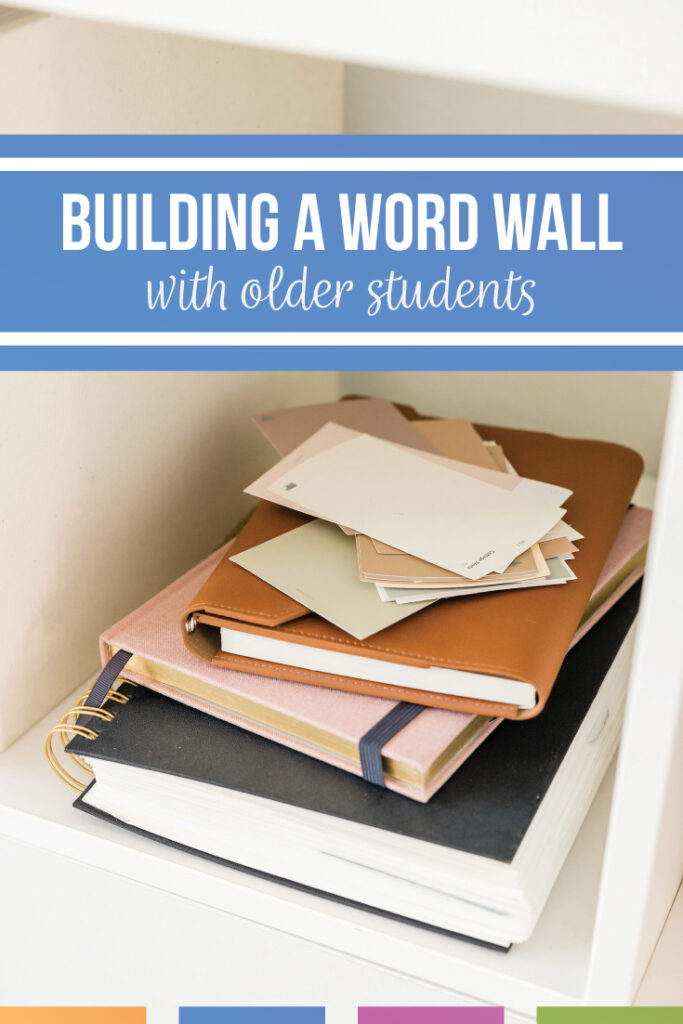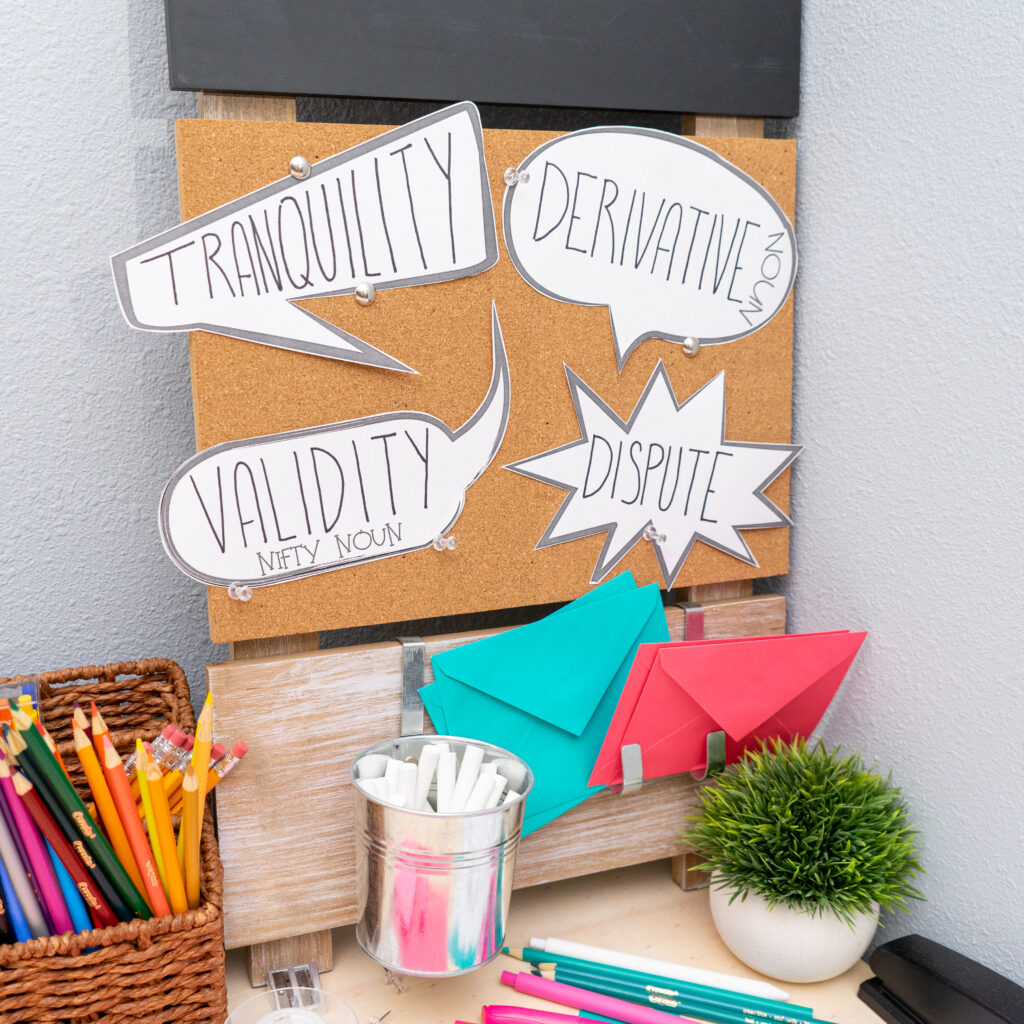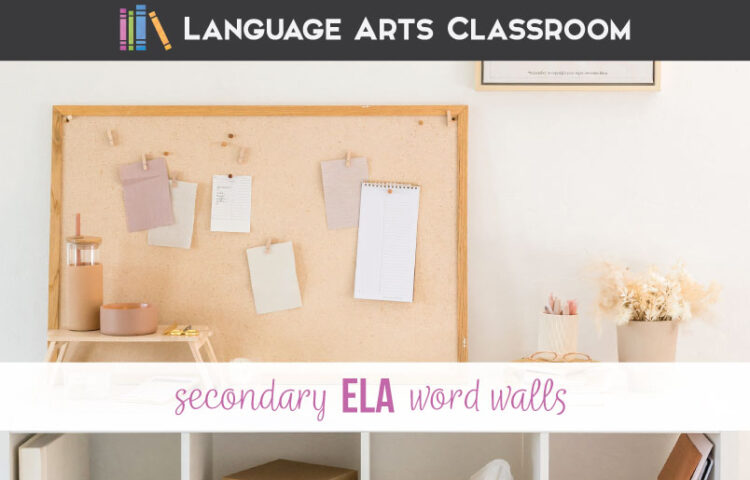Vocabulary word walls in secondary ELA provide a visual learning opportunity for students.
I use word walls with my high school English teachers and love the process. Previously, I’ve written about teaching grammar and vocabulary together to meet those upper language standards, and I included word walls as a possibility. In this post, I’ll answer other questions:
- How can I keep up with word walls? Short answer: students make the word walls.
- Where do I find the words? Short answer: for a word wall, any words will work!
- What do I do with a word wall after I have created it? Short answer: engage with the words in a variety of ways.
Read on below for more detailed answers to concerning working with word walls in secondary ELA.

How can I keep up with word walls?
Right: Secondary ELA teachers lack a spare minute. Every day is crammed with grading and connecting.
My word walls are not fancy—some might even say messy, which is ok. . . because my students made them. My ninth grade students especially build an interactive word wall. Some tips for managing the process:
Use cardstock with basic frames for words, and keep a stack ready. Ask students to add the words, definitions, pictures, and “manipulations.” I use the term “manipulations” to show students how a word has different forms. For instance, the word precarious can be precariously (adverb) or precariousness (noun).
Basically, I help students start the word wall, and then they can add the pieces as we build. We typically end up with pictures, sample sentences, and inside jokes on sticky notes on the word wall as well.
Comprehension for all learners.
Possible! Our content area is dense. ELA teachers have different tiers of vocabulary and academic vocabulary. No magic PDF or bundle exists.
Vocabulary word walls in secondary ELA help though. Once you design a process that works for your classes, the engagement will help multiple learners.
Where do I find the words?
For a word wall, literally any words will work. I use words from nonfiction texts and literature, but if you have a vocabulary program that you love, you can easily add your own words to a word wall.
Another collection of words can come from student generated bookmarks. When students find words on their own, they are more invested in learning about the words. Students can use these graphic organizers or bookmarks with short stories, independent reading, or class novels.
When I teach The Great Gatsby, for instance, students and I spend time reflecting on Fitzgerald’s language and questioning his structure. Designing the word wall is simply part of the process. After we discuss the words, students take a frame and use one of the words.
What do I do with the word wall?
We have probably all seen word walls for younger grades. Often, the word walls are made of sight words or commonly used words. This prior use is great; students already have used word walls. With secondary ELA students, though, of course your interactions will be different.
The pieces can hang on an actual wall or bulletin board. Once the new words are displayed, continue with engagement.
Here are some ways to actually utilize the vocabulary word walls in secondary ELA.
Talk about the words.
Looking for a bell ringer? Have three minutes left at the end of class? Perfect. Talk about your words on the word wall. Practice comprehension with the definitions. Practice manipulating the words.
You can casually use your vocabulary word walls in secondary ELA , but you can also use specific options:
Use Fast Mapping.
Say the word, point to it on the word wall, have students repeat it, immediately give a synonym, then give a synonym that a younger student could understand, then physically act out the word (move your body/hands/etc.)
For example, if the vocabulary word is acceleration, I would introduce it like this: “Okay everyone, the word is acceleration, say it with me acceleration.
Acceleration means to gather speed, or go fast. So, if I’m walking at this pace *walking slowly*, to accelerate I would… *walk faster*”. . .
Vocabulary instruction needn’t be fancy! A quick discussion can help your classes.
Repeat Words.
The more students are exposed to or hear a word aloud, the better. In fact, according to a study by Neuman and Wright (2014), only 20% of students who heard a word three times remembered it. They found that after 24 repetitions of the word, the majority (80%) of students successfully remembered what it means.
Ideas to prompt students to talk about words:
-
- As a warm up activity, have students engage in a brief 5 minute discussion using a vocabulary word and give them a starter to do so. Emphasize that they must use the starter to begin in order to ensure they are repeatedly hearing/saying the word. For example…Say: “Turn to your partner and begin a discussion using this starter: One example of an object accelerating is…
- Play the example/non-example game with students. Show students a sentence on the board, and ask them to say the vocabulary word if it is an example of the word. For example: If you think the sentence is an example of interior, say “interior”On their vacation, the family visited a lake in the middle of Montana.
- On their vacation, the family visited the coast of Oregon.
- As a warm up activity, have students engage in a brief 5 minute discussion using a vocabulary word and give them a starter to do so. Emphasize that they must use the starter to begin in order to ensure they are repeatedly hearing/saying the word. For example…Say: “Turn to your partner and begin a discussion using this starter: One example of an object accelerating is…
- As a warm up activity, have students engage in a brief 5 minute discussion using a vocabulary word and give them a starter to do so. Emphasize that they must use the starter to begin in order to ensure they are repeatedly hearing/saying the word. For example…Say: “Turn to your partner and begin a discussion using this starter: One example of an object accelerating is…
- Play the example/non-example game with students. Show students a sentence on the board, and ask them to say the vocabulary word if it is an example of the word. For example: If you think the sentence is an example of interior, say “interior”On their vacation, the family visited a lake in the middle of Montana.
- On their vacation, the family visited the coast of Oregon.
- On their vacation, the family visited a lake in the middle of Montana.
- On their vacation, the family visited the coast of Oregon.
Help students understand that they have a way to apply the vocabulary word by prompting them to describe their own experiences. For example: Say: “Have you ever arranged something in an array? How did you do it?”
The repetition of words might seem unnecessary when you start practicing them like this, but students will remember the words and terms the more you deal with the words.
Write the words.
Use the two-column note strategy to break down vocabulary definitions into memorable chunks/phrases. All you need is to make two columns on a Google Document.
For example, use the word “telescope.” (Add the word in the first column with its definition.) In the second column, brainstorm memorable connections to the word:
Instrument to see far away objects.
- Who: scientists, tourists
- What: planets, stars, monuments
- When: during experiments, on vacation
- Where: top of tall buildings, observatory
- Why: to answer questions, to make observations, enjoyment
- How: focus lens
When students write their vocabulary words, they sometimes fall into easy patterns, often the subject + linking verb + predicate adjective pattern. (A telescope is fun.) Some guidelines for students to write words:
1. Require students to apply the vocabulary word in a different context by giving them sentence starters. Increase the level of complexity as students receive more exposure to the word.
I would be reluctant to _____________ because ___________.
The vista stretched out to the horizon from where we stood on the ___________.
2. Conduct quick writes to expand vocabulary usage. Challenge students to use a set number of words from the word wall. As a bonus, add the sentences to the word all.
3. Challenge students to incorporate more than one vocabulary word in their writing by answering a yes or no question using two juxtaposed vocabulary words.
Could you find a beautiful vista in the interior of a state? Why or why not?
Would you be resistant to the Union if you were entrenched in the principles of a state’s rights? Explain your thinking.
Starting the sentences for students will lead to their own creative sentences.
Overall use of vocabulary word walls in secondary ELA.
My point? The exercises with the word walls do not need to be preplanned, elaborate, or heavy. Working toward language standards can involve conversations and small activities with students. Will every discussion be a home run as far as understanding and vocabulary use? No. Will your vocabulary word wall necessarily be pretty? Maybe not! Will your students add goofy pictures to help them remember their words? Hopefully!
The purpose of the word wall is to have a visual display of learning. As you work with the words, you will be modeling how to build vocabulary. Sometimes, learning is messy.
My message with vocabulary lessons for secondary ELA students: Engage with the words. Experiment. Play, rearrange, and use. Look at the word in the dictionary and connect to prior knowledge.


